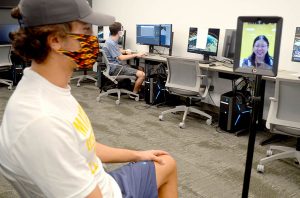October 02, 2020

Weiyu Feng uses virtual reality goggles to experience a classroom he is not physically in. Through the goggles, he can see classmate Will Slama in a realistic setting rather than on screen.
Students unable to attend in-person classes in the future could still get the full classroom experience, thanks to emerging virtual environment technologies. Fang Wang—an assistant teaching professor in the Information Technology program—is testing out such concepts this semester in her virtual reality class.
The VR class is designed to be in person, as students use sophisticated computer hardware and equipment not typically available at home. However, COVID-19 restrictions require students to stay home if they’re not feeling well.
Now, those who can’t come in person may navigate the classroom via a 360 video online. Or, they can put on VR goggles and be surrounded by the classroom in real time.
“Educational engagement is an area we were exploring anyway, in terms of VR application,” Wang said. “It just happens that now we are in a situation to try it ourselves.”
The technology is in its infancy stage. Wang is finding that many who have used the goggles switch to watching the class online after the initial “wow” factor is gone. That’s because current VR equipment is cumbersome.
“Eventually, though, it will advance to the point you won’t have to wear a heavy headset,” she said. “You could wear glasses and you would be in the virtual room. It’s like when cell phones first came out. They were very large. Now, everybody carries them in their pockets.”
Visiting from Afar
Wang is also experimenting with a telepresence robot. This two-wheeled driving robot is mounted with an iPad. The robot would allow instructors to visit a classroom even when they’re not there. Instructors would control the robot’s movement from their laptop, where they can see what’s happening through the iPad’s camera lens.

Senior Francesko Saliaj talks to Assistant Teaching Professor Fang Wang through a telepresence robot.
On the other side, students can see and talk to that instructor. That means while another teacher or assistant physically oversees the class, the instructor can work virtually with students who need help.
Wang also envisions using the robots to allow people to visit from anywhere. The IT Program offers degrees and certificates 100% online, meaning students can attend without ever having to come to campus.
“They could drive the robot and take a spatial tour of our labs and talk to faculty and students,” she said. “In our scenario where people are remote naturally, this could be a way to connect them to the physical campus.”
A Growing Interest
While students in the VR class aren’t necessarily part of providing the virtual classroom experience, it is a discussion topic. And more students are showing an interest in the field, Wang said.
“We see a lot more students interested in virtual and augment reality,” she said. “There’s excitement around this new technology, and they recognize that this is a marketable skill.”
Wang also serves as faculty advisor for the Virtual Reality Club, which introduces students to VR through games, simulations, and development. The club allows members to test their skill sets through object-oriented programing, modeling, and scripting in a 3D/360 virtual environment.